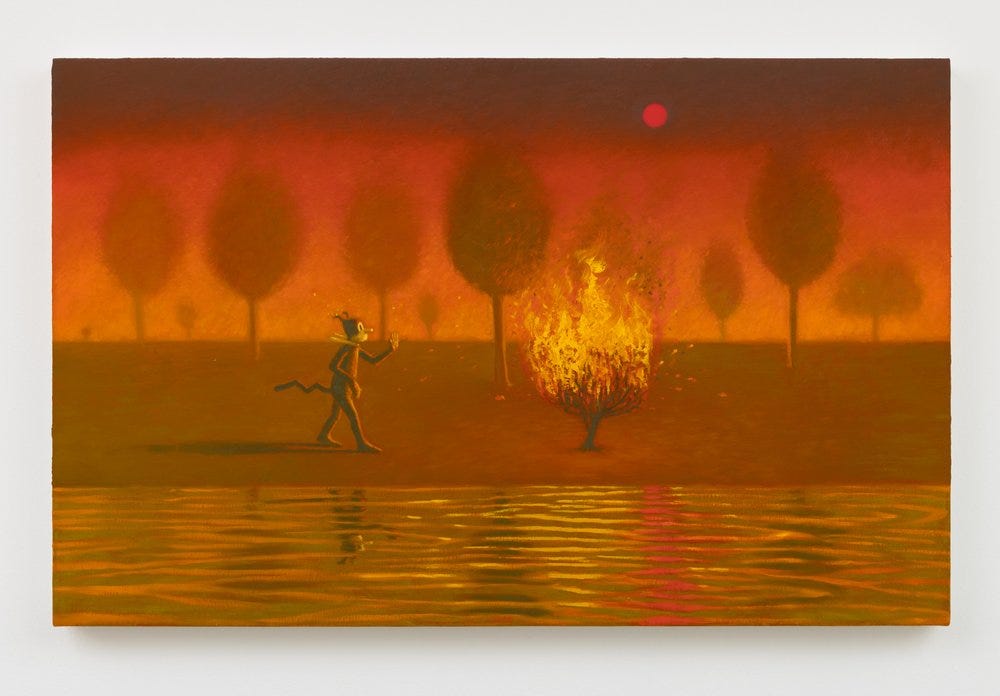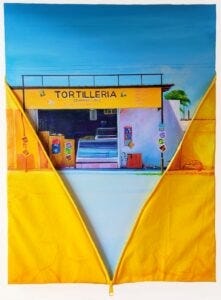Ordinary and Extraordinary
Paintings (and more) by Vonn Cummings Sumner, Paloma Vianey, Artemis Herber, and Benjamin Duke derive from comics, history, and everyday life
Vonn Cummings Sumner, "Krazy Season (Wildfire)" (Morton Fine Art)
AMONG THE TRADEMARKS OF GEORGE HERRIMAN'S "KRAZY KAT" are ever-changing, semi-surreal backdrops inspired by the desert near the artist's Arizona vacation home. The backgrounds are just as notable in recent paintings by Vonn Cummings Sumner, who's been riffing on Herriman's 1913-1944 comic strip for about five years. The latest work in the series, on exhibit in Morton Fine Art's "Krazy Season," is the lushest yet. Yet some real-world threats can be discerned amid the wonderland of popsicle trees and cotton-candy skies.
Sumner lives in southern California, whose climate is alternately congenial or catastrophic. This is expressed by the dozen paintings, in which Herriman's black cat ambles through flatly hard-edged landscapes that transform the washed-out hues of newsprint comics into exuberant oil-paint colors. Instilled in the order the artist specified, the cycle proceeds from spring to winter. In the last two pictures, the jagged-tailed feline travels by ice-skates or snowshoes, respectively.
By the final painting, the cat has moved near the right-hand border, and thus almost out of the frame. This doesn't necessarily represent progress toward an ultimate destination. The pictures are "both a metaphor for navigating a constantly changing world, and a vicarious walking meditation," says the artist's statement.
All the compositions are horizontal, and all but one feature a band of water across the bottom. This river-like feature is usually placid and mirror-like, so as to reflect the many varieties of cartoonish trees, as well as skies that range from midnight blue to hot pink. But the styles or color schemes shift significantly in two paintings, both among the most recent ones. "Krazy Season (Winds of Change)" is executed mostly with black lines on raw canvas, signifying the roughness of the cat's struggle against a strong headwind that's also whipped the water into rolling whitecaps. Painted almost entirely in red and orange, "Krazy Season (Wildfire)" centers on a burning bush, suggesting that California's recent conflagrations are of Biblical magnitude.
Since they're derived from comics and rendered in a repetitive format that suggests mechanically generated material, Sumner's new paintings evoke 1960s pop art. But where Warhol and Lichtenstein riffed on the endless banality of mass-media images, Sumner seeks a wealth of variation within a repeated schema. His Krazy Kat, as Heraclitus might have mused, never steps past the same river twice.
Paloma Vianey, Chamarra no. 6: Tortillería (IA&A at Hillyer)
UNUSUALLY FOR THE VENUE, IA&A AT HILLYER IS PRESENTING THREE SHOWS that feature painting. Yet none of the artists restricts herself or himself to images on a two-dimensional surface. They venture into sculpture or video, or simply vary their work with a two-ply approach.
That's the strategy of Mexico-born D.C. artist Paloma Vianey, whose pictures have been featured in several recent local group shows. Vianey realistically paints quiet scenes from her hometown, Ciudad Juárez, a city once known as among the world's most dangerous. She often depicts simple commercial structures, but also paints desert vistas and a graceless modernist building of the sort that jar nearly all cities. People don't appear in her pictures, which present the landscape as a stage set awaiting a cast of players.
To express her warmth for Ciudad Juárez, Vianey warps each vignette in an actual chamarra, Spanish for "jacket." These partly unzipped garments frame the scenes, which appear to continue under fabric that tints but doesn't obscure the subject. (This show also includes a set of 16 small unjacketed paintings.) It's a clever if limited format, and the pictures are deftly painted and appealingly bright. All the yellow and pink makes Ciudad Juárez, although portrayed with documentary precision, seem as almost enchanted as Sumner's comic-al universe.
The most aggressively 3D of the shows, Artemis Herber's "Danger Zones: Beyond the Past" combines her longstanding interests in history and archaeology -- especially of the Greco-Roman world -- and the ravages of today's Anthropocene era. The German-Greek Baltimore-area artist continues to work with corrugated cardboard, which she employs here both for sculpture and as the medium for paintings and drawings. Among her other materials are caution tape, used for its symbolic value, and marble dust and coal.
Herber evokes death, ritual, and ancient sites with a series that depicts urns of the sort used to hold human remains. These represent humanity's eternal desire to manage and organize demise and decay. The artist's ragged cardboard constructions, however, offer a competing story. Decay is inevitable, and probably accelerating as civilization stands on what the artist's statement calls "the precipice of collapse."
In the land of Nod: The fearful tale of the Essex (IA&A at Hillyer)
Commonplace people and events acquire a mythic quality in Benjamin Duke's history paintings, rendered in a realistic style that recalls New York City's century-old Ashcan School. The Baltimore-educated, Michigan-based artist’s “Chance Factor” portrays lesser-known characters, some of them nonetheless central to history. Thus his "imaginary portrait" of Gavrilo Princip, who killed Archduke Franz Ferdinand and sparked World War I. Behind the assassin is what appears to be an abstract-expressionist painting, suggesting that late-20th-century art was among the random aftereffects of Princip's deed.
An even more obscure figure, Hiroo Onoda, inspired Duke to put down his paintbrush. The Japanese soldier in the Philippines jungle who refused until 1974 to believe that World War II was over, Onoda is the subject of a stop-motion video shot in a small diorama that's also on display. Looping on a tiny screen, the video is the littlest thing in a show whose paintings are mostly large and burly enough for a grand 19th-century picture gallery. Perhaps the video's scale is meant to suggest the poignant insignificance of Onoda's stubborn obedience to a defeated regime. Or maybe Duke figures that history itself has gotten smaller as humanity approaches collapse.
Vonn Cummings Sumner: Krazy Season
Through March 31 at Morton Fine Art, 52 O St. NW, #302. mortonfineart.com. 202-628-2787. Open by appointment.
Benjamin Duke: Chance Factor
Artemis Herber: Danger Zones: Beyond the Past
Paloma Vianey: Don't Zip Me Up
Through March 30 at IA&A at Hillyer, 9 Hillyer Court NW. athillyer.org. 202-338-0680.





